Effective Strategies for Managing Fruit Fly Infestations
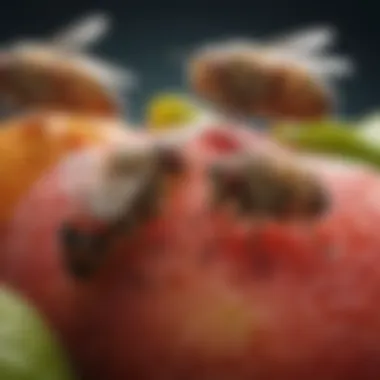
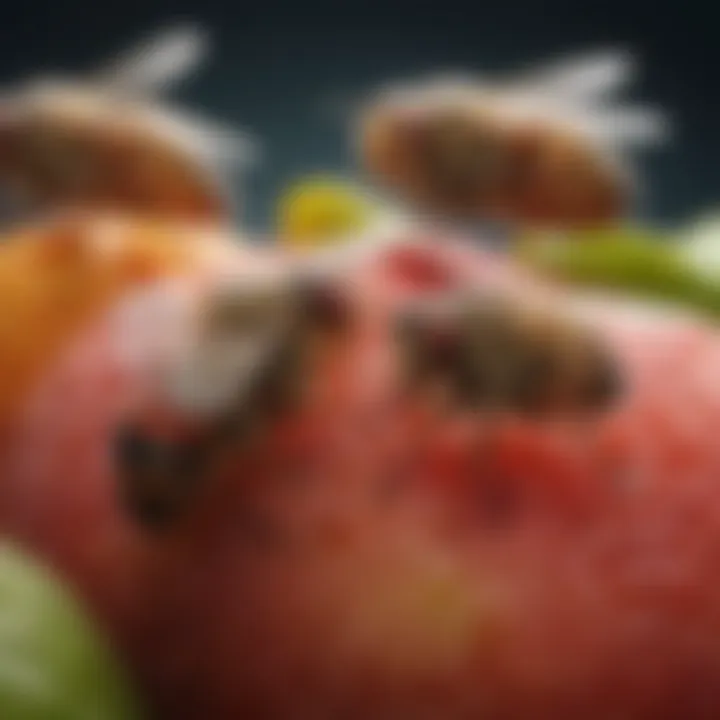
Intro
Fruit flies, or Drosophila melanogaster, are small insects that become a significant nuisance in homes and gardens. Their presence may seem trivial, but understanding their behavior, breeding habits, and life cycle is crucial for effective management. Infestations can arise quickly, often making it overwhelming for homeowners to control them. In this article, we will explore the various aspects of fruit fly infestations. We will cover techniques for prevention and control, as well as discuss eco-friendly solutions that align with sustainable living principles.
Understanding Pests
Definition of Pests
Pests are organisms that cause harm to crops, livestock, or human habitats. They compete for resources, transmit diseases, and degrade the quality of life in their environments. Fruit flies fall within this category as they are primarily attracted to decaying or fermenting substances, making them a common sight in kitchens and gardens.
Importance of Pest Identification
Identifying pests accurately is critical for managing them effectively. Knowing that you are dealing with fruit flies can guide you to specific control strategies. Their small size, usually about 1/8 inch long, and their ability to reproduce rapidly make them particularly challenging to manage once they establish a presence. They often breed in moist environments, especially near overripe or rotting fruits.
A simple fruit fly infestation can escalate quickly into an overwhelming problem if not addressed timely.
Prevention Techniques
Home and Garden Preventative Measures
Preventing fruit fly infestations starts with maintaining cleanliness. Here are several strategies:
- Keep surfaces clean: Regularly wipe down counters, cutting boards, and tables to remove food residues.
- Store food properly: Seal fruits and vegetables in airtight containers to deter flies. This is particularly important for overripe produce.
- Dispose of waste: Empty trash bins frequently and composting materials should be managed properly.
- Inspect plants: Regularly check potted plants for any signs of fruit fly activity, such as tiny larvae.
Seasonal Prevention Tips
Fruit fly populations can fluctuate with seasons. During warmer months, they multiply rapidly. Consider these seasonal tips:
- Spring Cleaning: Conduct thorough cleanings during spring to eliminate potential breeding grounds.
- Fall Storage: Store fruits and vegetables at cooler temperatures during the fall to slow down breeding.
Eco-Friendly Pest Control Solutions
Overview of Sustainable Practices
Adopting eco-friendly pest control methods is essential for both the environment and your home. These practices focus on prevention and safe removal of pests without harming the surrounding ecosystem. Using methods like sticky traps can catch adult flies while allowing you to avoid chemicals that could harm beneficial insects.
Natural Remedies and Their Effectiveness
Several natural remedies help combat fruit fly infestations:
- Apple Cider Vinegar Trap: Fill a jar with apple cider vinegar covered with plastic wrap. Poke small holes in the wrap; flies are attracted to the vinegar and cannot escape.
- Essential Oils: Oils like lemon or peppermint can deter flies. Mix with water and spray around the kitchen.
- Basil Plants: Placing basil plants in your kitchen can repel fruit flies due to their strong scent.
Finally, it is important to stay observant and proactive. By recognizing early signs of infestation and utilizing effective preventive measures, homeowners can manage fruit fly problems with greater ease. The knowledge of sustainable practices not only aids in eliminating these pests but also contributes positively to the environment. Readers are encouraged to explore more about fruit flies and pest management strategies through reputable sources like Wikipedia or Britannica.
For a comprehensive understanding, frequent monitoring and awareness of pest behaviors in your home can prevent fruit flies from taking hold.
Preface to Fruit Flies
Fruit flies are a common nuisance in many households. Their presence can lead to unease and concern, particularly in kitchens or dining areas where food is present. Understanding fruit flies is the first step toward effectively managing their presence. This section aims to provide insights into what fruit flies are, their behavior, and why they can easily infest our homes.
Defining Fruit Flies
Fruit flies, scientifically known as Drosophila melanogaster, are small insects often seen hovering around overripe or decaying fruits. They are about 1/8 inch in length and are mainly characterized by their tan body and red eyes. While their small size may make them seem inconsequential, they are prolific breeders. A single female can lay up to 500 eggs in her short lifetime, which leads to quick population growth when conditions are suitable. The rapid breeding cycle of fruit flies requires homeowners to take swift action if they notice an infestation.
Common Species of Fruit Flies
There are several species of fruit flies, but the most prominent ones include:
- Drosophila melanogaster: This is the most common species found in homes. They prefer fruits such as bananas, apples, and berries.
- Drosophila simulans: This species is often found in more specific environments, especially those with fermenting material.
- Drosophila repleta: Common in warmer regions, they are attracted to both fruit and rapidly decaying organic matter.
Understanding these species helps in identifying the origins of the infestation and the best methods to prevent future occurrences. It's important to recognize the specific traits of each species, as their preferences can differ, impacting control strategies.
Biology and Behavior of Fruit Flies
Understanding the biology and behavior of fruit flies is crucial for effective management within homes. Grasping their lifecycle and feeding habits allows homeowners to implement targeted strategies. This section discusses how the innate characteristics of fruit flies contribute to their presence in domestic environments.
Lifecycle of Fruit Flies
Fruit flies, specifically the Drosophila melanogaster, exhibit a rapid lifecycle. The entire process, from egg to adult, can occur in just a week under optimal conditions. This swift reproduction enables them to establish large populations quickly, complicating control efforts.
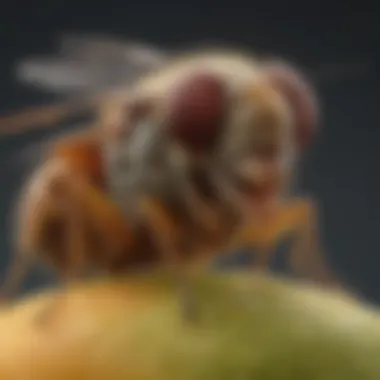
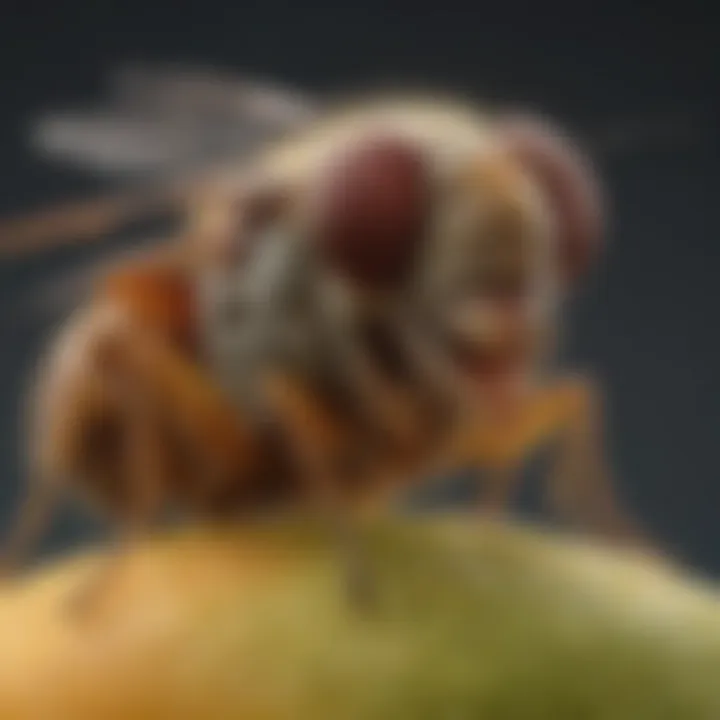
- Egg Stage: Female fruit flies lay clusters of eggs on fermenting or decaying fruit. Each female can produce hundreds of eggs in her lifetime.
- Larval Stage: After hatching, the larvae feed on the surrounding material, which is often decaying fruit. This dependency on fermenting substances is pivotal for their growth.
- Pupal Stage: Once they mature, they enter the pupal stage, where they undergo metamorphosis.
- Adult Stage: Adults emerge ready to seek more food sources and reproduce. Their life expectancy can reach several weeks to months depending on environmental factors.
Due to their short lifecycle and high reproductive rates, timely detection of infestations is necessary.
Feeding Habits and Preferences
Fruit flies are primarily attracted to sugary substances and decaying organic matter. This is where their foraging behavior plays a key role in attracting them to homes. They are notorious for infesting ripe fruit, vegetables, and even fermented drinks.
- Preferred Food Sources:
- Feeding Behavior: Fruit flies use their specialized mouthparts to lap up liquids. They locate food through smell, and their attraction to sweet scents is well-documented. This olfactory sensitivity allows them to detect ripe fruits at considerable distances, making prevention more challenging.
- Ripe bananas, peaches, and apples.
- Fermented drinks such as beer and wine.
- Any organic waste like old produce, which promotes breeding.
Recognizing their specific feeding habits is essential for effective management. If food sources are not removed or secured, infestations will likely reoccur, underscoring the importance of proactive measures.
Attractants for Fruit Flies
The presence of fruit flies in the home is often linked to specific attractants that entice these pests to invade living spaces. Understanding what draws fruit flies can aid in developing effective prevention and control strategies. The elements that attract fruit flies primarily include food sources and environmental conditions.
Common Food Sources
Fruit flies are known for their attraction to ripe, overripe, and decaying fruits and vegetables. Some of their preferred food sources include:
- Apples
- Bananas
- Grapes
- Tomatoes
- Potatoes
- Onions
These food items release ethylene gas as they ripen, signaling to fruit flies that they are ready for consumption. Additionally, fruit flies are not limited to just decaying fruits; they may also feed on:
- Sugary substances, such as soda or juice
- Fermented foods and beverages like wine or beer
- Sweet syrups and vinegars
Keeping these items sealed and storing them properly can reduce attractants. Even the smallest pieces of food left out can serve as breeding grounds. Ultimately, maintaining cleanliness in kitchens and other food storage areas is essential for prevention.
Environmental Factors Contributing to Infestation
Certain environmental conditions can enhance the likelihood of fruit fly infestations. These factors often create an ideal atmosphere for fruit flies to thrive. Notably, the following elements are critical:
- Warm Temperatures: Fruit flies prefer warm climates. Higher temperatures promote faster development of larvae.
- Moisture: Excess moisture in areas like sinks, drains, or damp surfaces can provide breeding grounds. Leaky pipes and standing water should be addressed.
- Poor Air Circulation: Stagnant air can create a conducive environment for fruit flies to multiply. Ensuring good airflow can help deter them.
- Trash and Debris: Overfilled trash cans or litter can attract fruit flies. Regular disposal of waste keeps the area less appealing for these pests.
"A clean, well-organized environment is the first line of defense against fruit fly infestations."
To properly manage fruit fly populations, understanding these attractants is essential. Addressing food sources and environmental factors will create less favorable conditions for fruit flies, thereby reducing the likelihood of infestations.
Identifying the Signs of Infestation
Identifying signs of fruit fly infestation is crucial for effective management. Early detection helps homeowners take action before the problem escalates. By recognizing specific indicators, it is possible to implement control measures swiftly. This section emphasizes the value of understanding the signs to prevent a fruit fly population from growing unchecked.
Visual Indicators
Visual signs can be the first clue to a fruit fly problem. Adult fruit flies are small, typically measuring about 1/8 inch in length. They are often seen buzzing around ripe or rotten fruits and vegetables. Pay attention to areas where food is located. Common spots include countertops, garbage bins, and fruit bowls.
Common visual indicators include:
- Presence of Adult Flies: Look for small, dark flies, particularly near food sources.
- Fruit Damage: Look for punctures or soft spots on fruits, which may indicate fruit flies laying eggs.
- Larvae or Pupae: Tiny white maggots might be seen crawling on overripe produce or within containers.
Detecting these signs quickly is essential. Removing infested food or cleaning surfaces can significantly reduce the chance of an outbreak.
Smells and Odors Associated with Infestations
Smells can serve as another indicator of a fruit fly infestation. Decomposing organic material emits a distinct odor that attracts these pests. Familiarizing yourself with these smells can aid in early identification. When fruit flies breed, they create a fermentation odor that is hard to miss.
Key smells to look for:
- Fermentation Smell: This scent often arises from spoiled fruits or vegetables.
- Musty Odors: They may come from trash cans or areas where food waste accumulates.
"Detecting foul odors is an important method for identifying potential breeding grounds for fruit flies."
Eliminating the sources of these odors is critical. Regularly check your kitchen and waste disposal areas for any signs of rot or spoilage. Maintaining cleanliness can help manage the appeal of a home to fruit flies.
By understanding and monitoring these visual and olfactory signals, homeowners can intervene before a full-blown infestation takes hold.
Prevention Techniques
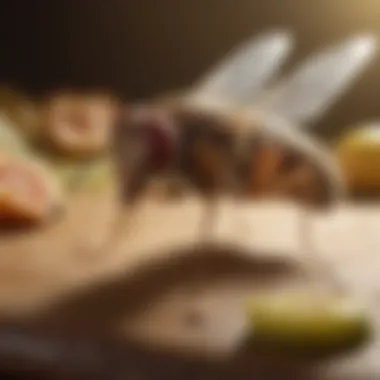
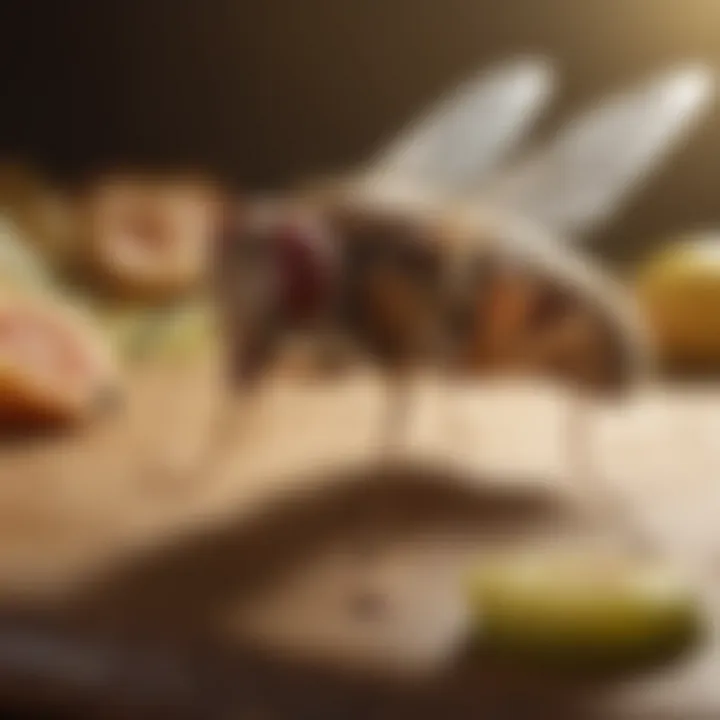
Preventing fruit fly infestations is a crucial aspect of home management. These pests proliferate quickly and can become a nuisance, leading to both hygiene concerns and potential damage to fruits and vegetables. By understanding and implementing effective prevention techniques, homeowners can significantly reduce the risk of an infestation. Here are detailed strategies focusing on maintaining cleanliness, ensuring proper food storage, and eliminating potential breeding grounds indoors.
Establishing a Clean Environment
Creating a clean living space is the first line of defense against fruit flies. These insects are attracted to organic matter, making cleanliness essential in deterring them. Regular maintenance of surfaces where food is prepared and consumed is vital.
- Wipe Down Surfaces: Make a habit of cleaning countertops, tables, and other surfaces after meals. A simple solution of vinegar and water can be effective against both the flies and the residues that attract them.
- Dispose of Waste Properly: Ensure that all food waste is sealed tightly in containers that are emptied regularly. This action prevents flies from accessing potential breeding materials.
- Maintain Sink Hygiene: Your kitchen sink can be a breeding ground for fruit flies. Clean drains regularly, as leftover food particles can create the ideal environment for fly larvae.
By establishing these practices, you create a less hospitable environment for fruit flies.
Proper Food Storage Practices
One key to preventing fruit fly infestations lies in proper food storage. The way food is stored in your home can either attract or repel these pests.
- Use Airtight Containers: Store fruits and vegetables in airtight containers. This method not only keeps them fresh longer but also prevents flies from laying eggs on them.
- Refrigerate Perishables: Many types of fruits, especially overripe ones, should be stored in the refrigerator. Cold temperatures deter fruit flies from accessing these food sources.
- Check Deliveries: When grocery shopping, inspect fruits and vegetables for any signs of existing infestations before bringing them into your home. Disposing of infested items immediately can prevent a larger issue later.
Implementing these food storage practices will minimize the chances of attracting fruit flies.
Eliminating Breeding Grounds Indoors
Identifying and removing potential breeding sites is essential to effectively prevent fruit fly infestations. These pests thrive in areas where organic material is present.
- Regularly Clean Under Appliances: The spaces under stoves and refrigerators often accumulate spilled food and moisture. Regular cleaning in these areas helps eliminate breeding grounds.
- Inspect Houseplants: Fruit flies can often be found around damp soil in potted plants. Consider allowing the soil to dry out between waterings and removing any rotting plant matter.
- Manage Composting Systems Wisely: If you compost organic material, ensure the compost bin is airtight and regularly turned. An open bin can attract pests and provide a breeding ground.
By focusing on these practices, homeowners can greatly reduce the likelihood of fruit fly infestations.
A clean environment, proper food storage, and the elimination of breeding grounds are proactive measures essential in keeping fruit fly infestations at bay.
Control Measures for Established Infestations
Addressing established fruit fly infestations requires a focused approach. Once these pests have taken hold in your home, swift action is essential to mitigate their impact. Implementing effective control measures not only reduces their numbers but also protects your living environment and food sources. Understanding these tactics ensures homeowners can act confidently and effectively, fostering a more pleasant and healthy space.
DIY Traps and Solutions
DIY traps are a popular and cost-effective way to combat fruit fly populations. Many households can create simple traps using items commonly found in the kitchen. One effective method involves using a mixture of apple cider vinegar and dish soap. Here's how to do it:
- Gather Supplies: You will need apple cider vinegar, dish soap, and a container. A jar or bowl works well.
- Prepare the Trap: Pour about an inch of apple cider vinegar into the container and add a few drops of dish soap. The soap breaks the surface tension, preventing the flies from escaping once they land.
- Placement: Set the trap near fruit bowls, garbage cans, or any area where fruit flies are commonly seen.
In addition to traps, there are other household solutions. For example, a mixture of sugar water and yeast can also attract and trap the flies. Placing this near infested areas may help in reducing their numbers significantly. Regular monitoring and adjustment of these traps will enhance their effectiveness.
Chemical Control Options
When DIY measures do not suffice, homeowners might consider chemical control options. These products can be useful, especially in severe infestations where rapid action is needed. However, caution is crucial when using these solutions to protect children, pets, and the environment.
When looking for chemical treatments, consider the following:
- Insecticides: Look for insect sprays specifically labeled for use against fruit flies. Ensure they are designed for indoor use. Always read the label and follow instructions for application.
- Foggers and Aerosols: These are effective for larger areas and can penetrate hard-to-reach places where fruit flies may be hiding. Again, safety precautions are key.
- Baits: Commercially available baits specifically made for fruit flies can attract and kill these pests. They are usually easy to use and can be placed in areas where you spot a lot of activity.
For effective control, always combine chemical treatments with sanitation practices and monitor their effectiveness.
Choosing the right approach requires understanding your specific situation regarding infestation severity and household dynamics. Whatever method you choose, effective communication to all household members about the methods being used is essential to ensure consistent efforts in managing these pests.
When to Seek Professional Help
Managing fruit fly infestations can be a challenging task. While many homeowners can take preventive measures or implement DIY solutions, there are situations where professional assistance becomes necessary. Recognizing when to seek help is crucial for effectively managing these pests and ensuring the health of your home environment.
Benefits of Professional Assistance
Engaging a pest control service offers several advantages.
- Expertise: Professionals possess extensive knowledge of fruit flies and their behaviors. This expertise enables them to identify specific species and determine the best course of action.
- Comprehensive Solutions: Pest control technicians evaluate your situation and develop customized plans. This ensures that the approach is tailored to your unique needs rather than using a one-size-fits-all method.
- Efficiency: Professionals have access to advanced tools and treatments that are often more effective than over-the-counter products.
- Long-term Results: A professional service can reduce the chance of re-infestation by addressing root causes and preventing future occurrences.
Considerations for Seeking Help
Deciding to hire a pest control service involves several factors. For one, you should assess the extent of your infestation. If you notice a rapid increase in fruit fly numbers or they persist despite your efforts, it may be time to consult a specialist. Additionally, if you have concerns about health risks associated with pests, such as contamination, professional help is advisable.
Assessing the Severity of Infestation
Determining the severity of a fruit fly infestation is a critical first step before calling in professional services. Begin by noting the frequency and locations of sightings. Pay attention to common areas where fruit flies are prevalent, such as kitchens or near ripening fruits. Conducting a thorough inspection helps identify whether the problem is localized or more widespread.
Look for the following indicators that may signal a severe infestation:
- High Numbers: If you frequently see fruit flies during daytime or at dusk, it may indicate a significant presence.
- Breeding Sites: Check for standing water, garbage, or overripe fruit. These areas are ideal breeding grounds.
- Persistence: If flies return despite efforts to remove food sources, the situation may be grave.
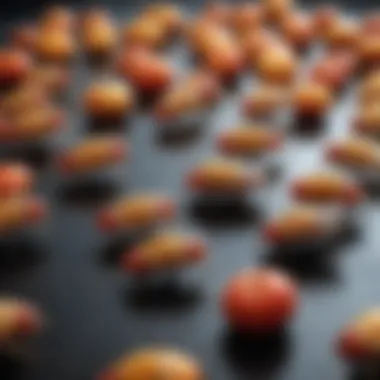
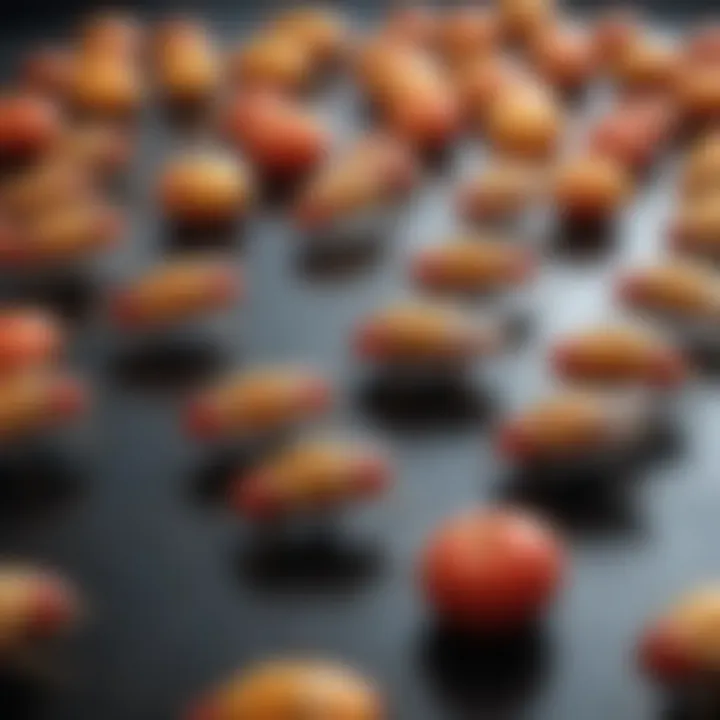
After assessing these factors, you can gauge whether it is appropriate to involve pest control professionals.
Choosing a Pest Control Service
If you have determined professional support is necessary, selecting the right pest control service is vital. A few strategies can aid in making this decision.
- Research Credentials: Verify that the service is licensed and insured. This will help ensure that they adhere to industry standards and regulations.
- Read Reviews: Check testimonials and reviews from previous customers. This will give you insights into their reliability and effectiveness.
- Request Estimates: Before deciding, contact multiple services to gather estimates. This will allow you to compare pricing and services offered.
- Inquire About Methods: Ask about their strategies for addressing fruit fly issues, including any eco-friendly options they may provide.
A thorough evaluation of these factors can lead to a choice that not only addresses the current infestation but also prevents future issues effectively.
Remember that the ultimate goal is to maintain a healthy living environment. A professional pest control service can provide peace of mind along with effective solutions.
Eco-friendly Approaches to Pest Management
Eco-friendly approaches to pest management are critical for anyone confronting fruit fly infestations in the home. These strategies focus on minimizing the impact on the environment while controlling pests effectively. By using natural methods, homeowners can reduce chemical residues, promote biodiversity, and create a safer living space for their families.
Sustainable Practices for Prevention
Sustainable practices are fundamental for preventing fruit fly infestations. These methods emphasize a proactive rather than reactive stance. One essential practice is maintaining a clean environment. Regularly disposing of spoiled fruits and vegetables ensures no food sources attract fruit flies. In addition, it is crucial to keep countertops and other surfaces free of food debris.
Proper waste management plays a significant role too. Ensure that garbage bins are sealed tightly and emptied regularly. Composting is an excellent way to recycle organic matter but should be done with care. Avoid composting rotten fruits, as they can quickly become breeding grounds for fruit flies.
Another sustainable practice involves practicing good food storage. Fridge and pantry organization can limit fruit fly access to their preferred food sources. Store fruits and vegetables in the refrigerator when possible or use sealed containers. Label containers to maintain freshness and avoid confusion about what is edible and what is not.
Being attentive to your surroundings also aids prevention. Repairing leaks and ensuring good drainage can prevent damp areas where flies thrive. Consider adding screens in windows and doors to keep pests out without impeding airflow.
Natural Predators of Fruit Flies
Introducing natural predators is another effective eco-friendly method for managing fruit fly populations. Predatory insects such as yellow jacket wasps can greatly reduce the number of adult fruit flies. These wasps hunt and feed on flies, providing a biological control method that can work well in gardens and near outdoor fruit sources.
Another potential ally is the nematode. These microscopic worms can attack fruit fly larvae in the soil. By adding nematodes to the garden, homeowners can effectively diminish the larvae population. It’s a non-toxic method that aligns well with sustainable gardening practices.
Natural pesticides made from plant extracts, such as neem oil, can also deter fruit flies. These products are usually safe around pets and children when used according to the label instructions. Organic solutions like vinegar traps are another easy way to capture flies without chemicals. Vinegar, especially apple cider vinegar, is a strong attractant.
"Sustainable pest management methods not only target the problem but also enhance the overall health of the ecosystem."
The Role of Fruit Flies in Ecosystems
Understanding the role of fruit flies in ecosystems is crucial for a comprehensive view of their existence. While they are often perceived merely as pests, fruit flies play significant roles in various ecological processes, particularly in decomposition and pollination. Their activities contribute to environmental sustainability, making their management an important topic for homeowners.
Contributions to Decomposition
Fruit flies are integral to the process of decomposition. Their larvae consume decaying organic matter, such as ripe fruits and vegetables. This activity helps break down this matter into simpler substances, which can then be reabsorbed into the soil. By facilitating this process, fruit flies contribute to nutrient cycling in their habitats.
Their rapid reproduction rate ensures that they can efficiently process decaying material before it becomes a breeding ground for other pests. This ensures that waste is managed effectively and does not contribute to larger hygiene issues within the home environment.
In addition, their presence signals a diverse and healthy ecosystem. The breakdown of organic matter by fruit fly larvae aids in maintaining soil quality, thus encouraging the growth of plants. It is essential to recognize that managing fruit flies should not only involve eradication but also understanding their natural contribution to the ecosystem.
Pollination and Biodiversity
Beyond decomposition, fruit flies also play a role in pollination. Many species are attracted to flowers in search of food sources. By moving from one flower to another, they assist in the transfer of pollen, thus facilitating plant reproduction. This activity helps to maintain biodiversity within ecosystems.
The ecological importance of fruit flies in the context of plant life cannot be overlooked. Their pollination services, although less prominent than those of bees, still contribute to the reproductive success of various plants. This, in turn, supports a broader array of wildlife that depends on those plant species for survival.
"Understanding the ecological roles of pests like fruit flies leads to more effective and sustainable management practices."
By acknowledging their significance, homeowners can approach fruit fly management with a balanced perspective that prioritizes not just control, but also ecological harmony.
End
The management of fruit fly infestations is essential for maintaining a healthy living environment. This article highlights crucial strategies and insights surrounding the biology, behavior, and preventive measures against these pests. By understanding how fruit flies thrive and reproduce, homeowners can take informed actions to mitigate and control infestations effectively. In doing so, they reduce the risk of fruit flies becoming a persistent issue.
Summarizing Key Points
Throughout the article, several key points have been emphasized. It is important to remember that:
- Fruit flies reproduce quickly, making early detection vital.
- Environmental cleanliness is paramount. A clean environment not only deters fruit flies but also enhances overall household hygiene.
- DIY solutions can be effective, but knowledge of when to seek professional assistance is equally critical.
- Eco-friendly pest management can help homeowners address fruit fly issues while minimizing ecological impact.
- Fruit flies, while often seen as nuisances, play roles in ecosystems; understanding this can foster a more balanced perspective towards pest management.
Final Thoughts on Management Strategies
The strategies for managing fruit fly infestations are multifaceted but can be streamlined. Starting with prevention is always preferable to dealing with an active infestation. Homeowners should prioritize sanitation practices, like regular cleaning and proper food storage, to make their homes less inviting to fruit flies.
Moreover, when infestations occur, utilizing both eco-friendly traps and commercial pest control options can yield successful results. However, awareness on the degree of infestation is necessary. Sometimes, professional pest control services might be needed for extensive issues.
Effective management requires not just immediate solutions but thoughtful consideration of one's approach to pest control.



